The NVIDIA GeForce GTX Titan X Review
by Ryan Smith on March 17, 2015 3:00 PM ESTOverclocking
Finally, no review of a GTX Titan card would be complete without a look at overclocking performance.
From a design standpoint, GTX Titan X already ships close to its power limits. NVIDIA’s 250W TDP can only be raised another 10% – to 275W – meaning that in TDP limited scenarios there’s not much headroom to play with. On the other hand with the stock voltage being so low, in clockspeed limited scenarios there’s a lot of room for pushing the performance envelope through overvolting. And neither of these options addresses the most potent aspect of overclocking, which is pushing the entirely clockspeed curve higher at the same voltages by increasing the clockspeed offsets.
GTX 980 ended up being a very capable overclocker, and as we’ll see it’s much the same story for the GTX Titan X.
| GeForce GTX Titan X Overclocking | ||||
| Stock | Overclocked | |||
| Core Clock | 1002MHz | 1202MHz | ||
| Boost Clock | 1076Mhz | 1276MHz | ||
| Max Boost Clock | 1215MHz | 1452MHz | ||
| Memory Clock | 7GHz | 7.8GHz | ||
| Max Voltage | 1.162v | 1.218v | ||
Even when packing 8B transistors into a 601mm2, the GM200 GPU backing the GTX Titan X continues to offer the same kind of excellent overclocking headroom that we’ve come to see from the other Maxwell GPUs. Overall we have been able to increase our GPU clockspeed by 200MHz (20%) and the memory clockspeed by 800MHz (11%). At its peak this leads to the GTX Titan X pushing a maximum boost clock of 1.45GHz, and while TDP restrictions mean it can’t sustain this under most workloads, it’s still an impressive outcome for overclocking such a large GPU.
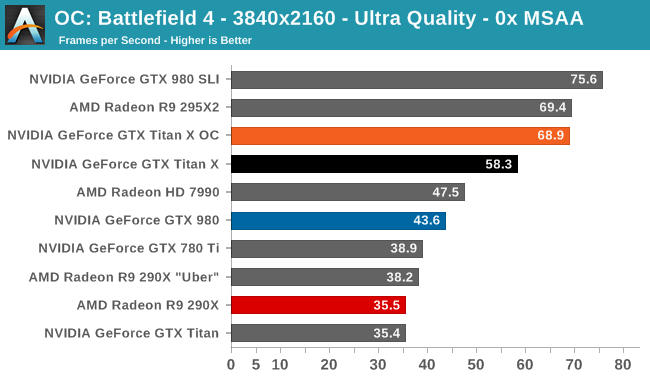
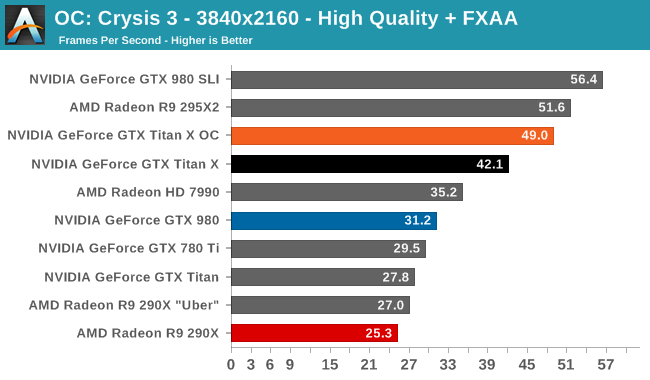
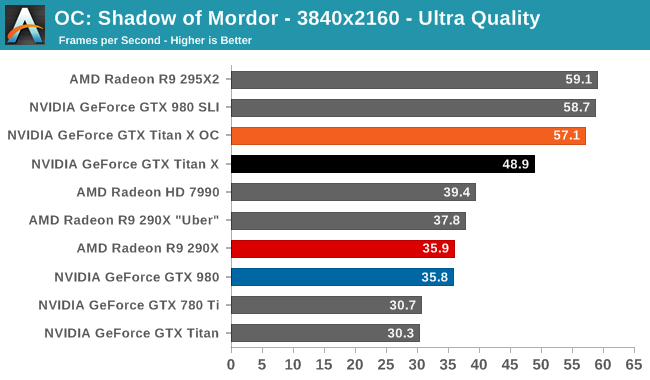
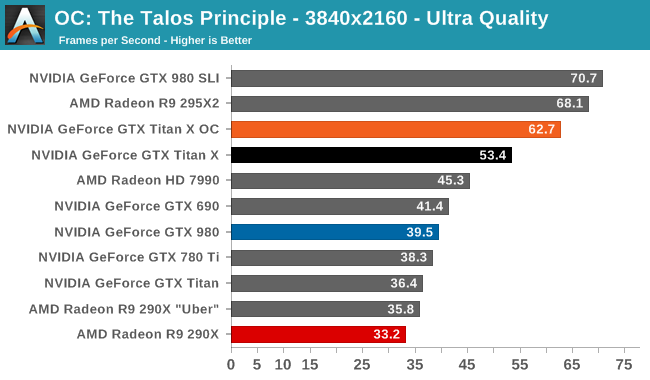
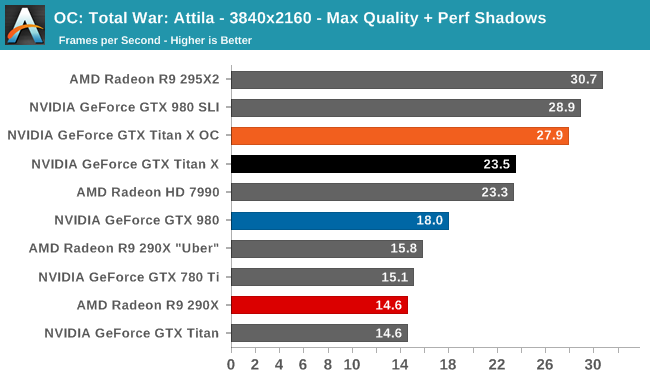
The performance gains from this overclock are a very consistent 16-19% across all 5 of our sample games at 4K, indicating that we're almost entirely GPU-bound as opposed to memory-bound. Though not quite enough to push the GTX Titan X above 60fps in Shadow of Mordor or Crysis 3, this puts it even closer than the GTX Titan X was at stock. Meanwhile we do crack 60fps on Battlefield 4 and The Talos Principle.
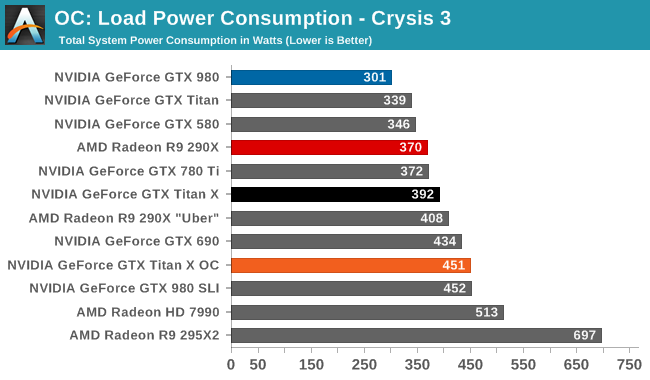
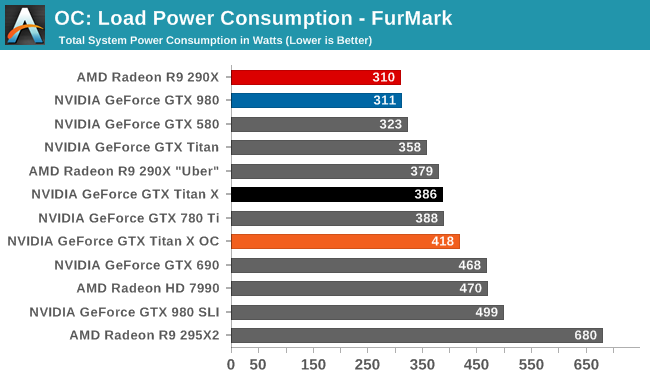
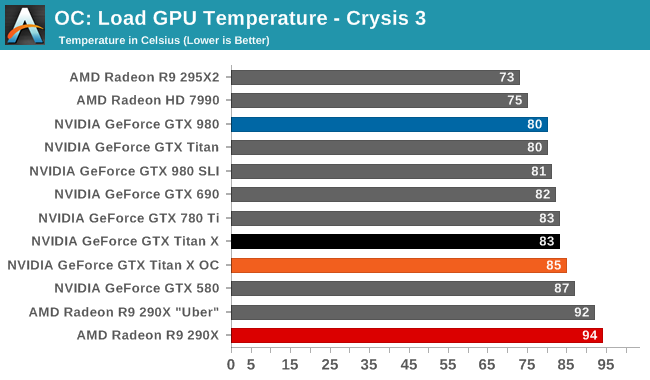
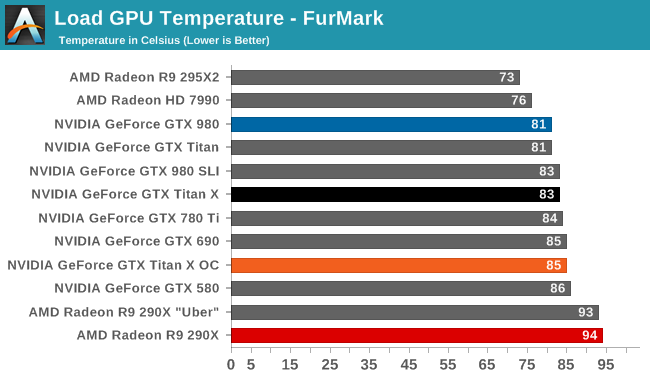


The tradeoff for this overclock is of course power and noise, both of which see significant increases. In fact the jump in power consumption with Crysis is a bit unexpected – further research shows that the GTX Titan X shifts from being temperature limited to TDP limited as a result of our overclocking efforts – while FurMark is in-line with the 25W increase in TDP. The 55dB noise levels that result, though not extreme, also mean that GTX Titan X is drifting farther away from being a quiet card. Ultimately it’s a pretty straightforward tradeoff for a further 16%+ increase in performance, but a tradeoff nonetheless.










276 Comments
View All Comments
Kevin G - Tuesday, March 17, 2015 - link
Last I checked, rectal limits are a bit north of 700 mm^2. However, nVidia is already in the crazy realm in terms of economics when it comes to supply/demand/yields/cost. Getting fully functional chips with die sizes over 600 mm^2 isn't easy. Then again, it isn't easy putting down $999 USD for a graphics card.However, harvested parts should be quiet plentiful and the retail price of such a card should be appropriately lower.
Michael Bay - Wednesday, March 18, 2015 - link
>rectal limits are a bit north of 700 mm^2Oh wow.
Kevin G - Wednesday, March 18, 2015 - link
@Michael BayIntel's limit is supposed to be between 750 and 800 mm^2. They have released a 699 mm^2 product commercially (Tukwilla Itanium 2) a few years ago so it can be done.
Michael Bay - Wednesday, March 18, 2015 - link
>rectal limitsD. Lister - Wednesday, March 18, 2015 - link
lolchizow - Tuesday, March 17, 2015 - link
Yes its clear Nvidia had to make sacrifices somewhere to maintain advancements on 28nm and it looks like FP64/DP got the cut. I'm fine with it though, at least on GeForce products I don't want to pay a penny more for non-gaming products, if someone wants dedicated compute, go Tesla/Quadro.Yojimbo - Tuesday, March 17, 2015 - link
Kepler also has dedicated FP64 cores and from what I see in Anandtech articles, those cores are not used for FP32 calculations. How does NVIDIA save power with Maxwell by leaving FP64 cores off the die? The Maxwell GPUs seem to still be FP64 capable with respect to the number of FP64 cores placed on the die. It seems what they save by having less FP64 cores is die space and, as a result, the ability to have more FP32 cores. In other words, I haven't seen any information about Maxwell that leads me to believe they couldn't have added more FP64 cores when designing GM200 to make a GPU with superior double precision performance and inferior single precision performance compared with the configuration they actually chose for GM200. Maybe they just judged single precision performance to be more important to focus on than double precision, with a performance boost for double precision users having to wait until Pascal is released. Perhaps it was a choice between making a modest performance boost for both single and double precision calculations or making a significant performance boost for single precision calculations by forgoing double precision. Maybe they thought the efficiency gain of Maxwell could not carry sales on its own.testbug00 - Tuesday, March 17, 2015 - link
If this is a 250W card using about the same power as the 290x under gaming load, what does that make the 290x?Creig - Tuesday, March 17, 2015 - link
A very good value for the money.shing3232 - Tuesday, March 17, 2015 - link
Agree.